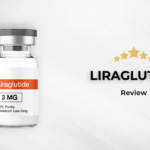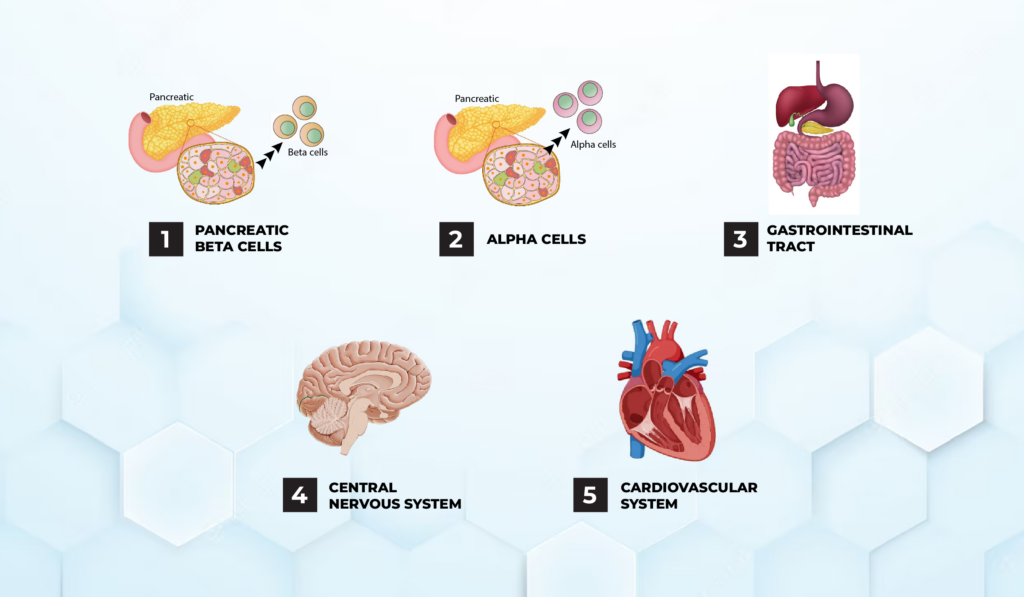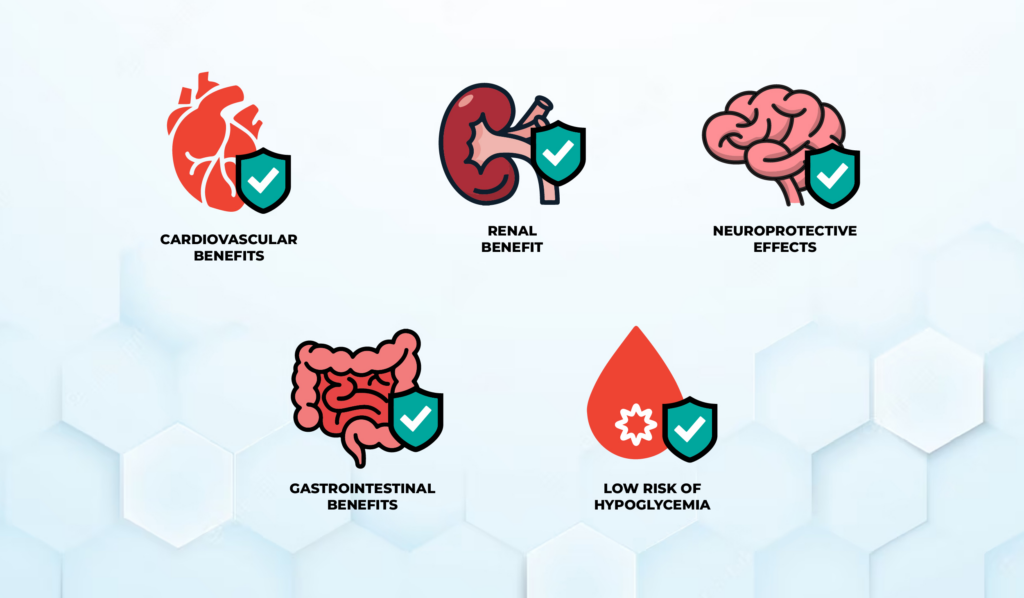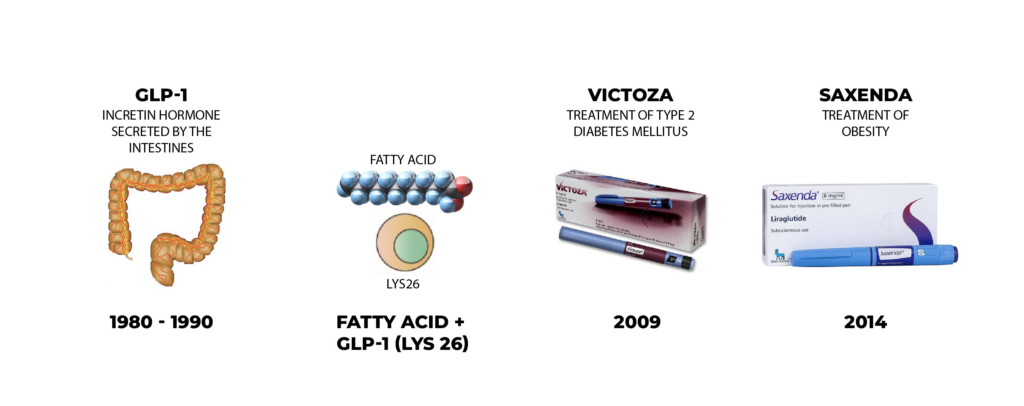
With a host of different fat loss meds on the market, Liraglutide treatment has its hands full with high expectations. This state-of-the-art weight management method seems to have supporting clinical trials, all showing that obese patients treated with this peptide seem to have better chronic weight management than untreated patients.
Weight loss is one of the biggest aims of modern medicine, as significant weight loss has been shown to lower cardiovascular risk factors and possible death.
So, is Liraglutide the next best thing? In this Liraglutide Review, we’ll be covering it all, making sure we look at the significant differences this peptide can bring into your life.
Key Takeaways
- Liraglutide is a medication that belongs to a class of drugs known as glucagon-like peptide-1 (GLP-1) receptor agonists
- Liraglutide is approved for use in the management of type 2 diabetes mellitus. It is often prescribed when lifestyle modifications and other oral medications fail to adequately control blood sugar levels
- Additionally, in some countries, liraglutide is approved for use in the treatment of obesity
- Common side effects of liraglutide include nausea, vomiting, diarrhea, constipation, abdominal pain, and decreased appetite
What is Liraglutide?
Liraglutide, a member of the glucagon-like peptide-1 (GLP-1) receptor agonist class, is a synthetic analog of human GLP-1 (7-37) modified to improve its pharmacokinetic profile. As a GLP-1 receptor agonist, liraglutide exhibits its therapeutic effects through the activation of the GLP-1 receptor, a G protein-coupled receptor primarily expressed in pancreatic beta cells, gastrointestinal tract, central nervous system, and cardiovascular system.
Liraglutide is indicated for the treatment of type 2 diabetes mellitus to improve glycemic control, either as monotherapy or in combination with other antidiabetic agents, including metformin, sulfonylureas, thiazolidinediones, and insulin. Additionally, it is approved for the management of obesity (brand name Saxenda) as an adjunct to a reduced-calorie diet and increased physical activity.
Clinical studies have demonstrated the efficacy of liraglutide in improving glycemic control, reducing HbA1c levels, and promoting weight loss in patients with type 2 diabetes. Moreover, liraglutide has been shown to lead to clinically meaningful weight loss in obese individuals.
How does Liraglutide work?

- Pancreatic Beta Cells: Activation of the GLP-1 receptor on pancreatic beta cells enhances glucose-dependent insulin secretion, thereby improving glycemic control without causing hypoglycemia in the fasting state.
- Alpha Cells: GLP-1 receptor activation inhibits glucagon secretion from pancreatic alpha cells, which contributes to the suppression of hepatic glucose production, further aiding in glycemic control.
- Gastrointestinal Tract: Liraglutide slows gastric emptying and reduces postprandial glucose excursions by delaying nutrient absorption in the gastrointestinal tract.
- Central Nervous System: GLP-1 receptors in the central nervous system regulate appetite and satiety, leading to reduced food intake and weight loss.
- Cardiovascular System: Liraglutide has been associated with cardiovascular benefits, including reductions in blood pressure, improvement in lipid profiles, and decreased risk of major adverse cardiovascular events in patients with type 2 diabetes at high cardiovascular risk.
What is a Glucagon Like Peptide 1?
Liraglutide
Liraglutide is a medication that belongs to a class of drugs known as glucagon-like peptide-1 (GLP-1) receptor agonists. It’s primarily used in the management of type 2 diabetes mellitus, although it has also been approved for weight management in certain individuals. This medication works by mimicking the action of a naturally occurring hormone called GLP-1, which helps regulate blood sugar levels by stimulating insulin secretion, reducing glucagon secretion, and slowing gastric emptying.
One of the significant benefits of liraglutide in the treatment of type 2 diabetes is its ability to improve glycemic control. By enhancing insulin secretion in response to elevated blood glucose levels and suppressing glucagon secretion, liraglutide helps lower blood sugar levels. This effect can lead to a reduction in hemoglobin A1c (HbA1c) levels, which reflects a person’s average blood sugar levels over the past two to three months.
Furthermore, liraglutide has demonstrated cardiovascular benefits beyond glycemic control and weight loss. Clinical studies have indicated that liraglutide can reduce the risk of major adverse cardiovascular events, such as heart attack, stroke, and cardiovascular-related death, in individuals with type 2 diabetes who are at high risk for cardiovascular disease.
Liraglutide Overview
 Top Benefits: Increases glycaemic control
Top Benefits: Increases glycaemic control  Form: Injectable liquid
Form: Injectable liquid Max Time Used: 6 – 8 Weeks
Max Time Used: 6 – 8 Weeks Average Cost: $59.99
Average Cost: $59.99 Side Effects: Allergic reaction
Side Effects: Allergic reaction Dangers: Allergic reaction
Dangers: Allergic reaction Best Peptide Stack: HGH / IGF-1 / HGH-Frag
Best Peptide Stack: HGH / IGF-1 / HGH-Frag
⚤ Men/Women: Men and women Go to the Full review
Go to the Full review
- Increases insulin control
- Decreases hunger
- Pain at the injection site
- Allergic reaction
Glucagon-like peptide 1 (GLP-1) is a peptide hormone that plays a crucial role in glucose homeostasis, particularly in the regulation of insulin secretion and glucose metabolism. It is produced primarily in the intestinal L cells located in the distal ileum and colon, as well as in the pancreatic α cells. GLP-1 is secreted in response to nutrient ingestion, especially carbohydrates and fats, and its secretion is augmented by the presence of glucose in the intestinal lumen.

GLP-1 exerts its effects through binding to the GLP-1 receptor, a G protein-coupled receptor expressed in various tissues, including pancreatic β cells, gastrointestinal tract, central nervous system, heart, and kidneys. Upon binding to its receptor, GLP-1 mediates several physiological actions:
- Insulin Secretion: GLP-1 stimulates glucose-dependent insulin secretion from pancreatic β cells, meaning that it enhances insulin release in the presence of elevated blood glucose levels but does not stimulate insulin secretion when blood glucose levels are low.
- Glucagon Secretion Inhibition: GLP-1 suppresses glucagon secretion from pancreatic α cells, which helps to reduce hepatic glucose production, thereby lowering blood glucose levels.
- Gastric Emptying Delay: GLP-1 slows gastric emptying, leading to a gradual and sustained absorption of nutrients from the gastrointestinal tract into the bloodstream. This results in blunted postprandial glucose excursions.
- Appetite Regulation: GLP-1 regulates appetite and satiety by acting on the central nervous system, particularly in the hypothalamus. It induces feelings of satiety, reduces food intake, and promotes weight loss.
- Cardiovascular Effects: GLP-1 has been associated with cardiovascular benefits, including vasodilation, improved myocardial function, and protection against myocardial infarction and heart failure.
History of Liraglutide
The development of liraglutide can be traced back to the discovery of incretin hormones, particularly glucagon-like peptide 1 (GLP-1), and their role in glucose metabolism. In the 1980s and 1990s, researchers identified GLP-1 as an incretin hormone secreted by the intestines in response to nutrient ingestion. GLP-1 was found to stimulate insulin secretion from pancreatic beta cells in a glucose-dependent manner and inhibit glucagon secretion from pancreatic alpha cells, thereby improving glucose homeostasis.

Building upon the discovery of exendin-4, scientists sought to develop a long-acting GLP-1 receptor agonist for the treatment of type 2 diabetes and obesity. Liraglutide was developed as a synthetic analog of human GLP-1 with modifications to improve its pharmacokinetic properties and resistance to degradation by DPP-4.
One key modification in liraglutide’s structure involved the addition of a fatty acid side chain at the amino acid lysine at position 26 (Lys26) of the GLP-1 peptide sequence. This modification facilitated the binding of liraglutide to albumin in the circulation, resulting in a longer half-life compared to native GLP-1 and exendin-4.
Liraglutide underwent extensive preclinical and clinical studies to evaluate its efficacy and safety in the treatment of type 2 diabetes mellitus and obesity. Clinical trials demonstrated liraglutide’s ability to improve glycemic control, promote weight loss, and reduce cardiovascular risk factors in patients with type 2 diabetes.
Liraglutide received regulatory approval for the treatment of type 2 diabetes mellitus under the brand name Victoza in 2009. Subsequently, it was approved for the treatment of obesity under the brand name Saxenda in 2014.
Liraglutide for Weight Loss
For this section, we’ll be looking at some studies. Liraglutide compared to other methods, vs a placebo group, Liraglutide versus placebo, and/or any other studies we can find.
- A Randomized, Controlled Trial of 3.0 mg of Liraglutide in Weight Management [1]: In this study, 3.0 mg of liraglutide, as an adjunct to diet and exercise, was associated with reduced body weight and improved metabolic control.
This 56-week study is one of the best of its kind. 3731 patients were monitored [3.0 mg (2487 patients) or placebo (1244 patients)], and the results all pointed to Liraglutide being an effective weight loss agent.
- Liraglutide for weight management: a critical review of the evidence [2]: Liraglutide helps to induce and sustain weight loss in patients with obesity. Its efficacy is comparable to other available agents but it offers the unique benefit of improved glycemic control. Additional studies are needed to determine its long term efficacy and safety profile.
This analysis did find that Liraglutide (along with lifestyle intervention) is an effective tool and can help even healthy subjects improve their overall health.
Overall, weight reduction is a huge benefit of Liraglutide. There are other benefits, such as a lower risk of injuries or ailments due to cardiovascular causes, which is key for overall health.
Other Benefits of Liraglutide Treatment
Cardiovascular Benefits
Liraglutide has been associated with cardiovascular benefits, including reductions in blood pressure, improvement in lipid profiles, and decreased risk of major adverse cardiovascular events in patients with type 2 diabetes at high cardiovascular risk.
Renal Benefits
Liraglutide has demonstrated renal benefits, including a reduction in the progression of diabetic kidney disease, in some studies. This is partly due to its ability to allow for a significant reduction in blood pressure. Blood pressure reduction will take a huge load off the kidneys, which is something those who suffer from diabetes mellitus should worry about! They have an increased risk of compromised kidneys, especially those with a higher body mass index.
Neuroprotective Effects
Some research suggests that liraglutide may have neuroprotective effects, potentially reducing the risk of cognitive decline and neurodegenerative diseases such as Alzheimer’s disease.
This point is still ‘on the fence’. There is no denying that better cardiovascular outcomes will be great for bodily health, but what about the mind? Well, healthy subjects have better mindsets. So, one could easily make the argument that a lower body mass index would mean a better mindset… Not always, but the evidence does exist.
Gastrointestinal Benefits
Liraglutide can improve gastrointestinal function by slowing gastric emptying and reducing gastric acid secretion, which may be beneficial for individuals with certain gastrointestinal disorders. This can help relieve stomach pain for some individuals, and because people feel fuller, they eat less, which means lower cardiovascular disease. Boom, many benefits just from pooping less…
Low Risk of Hypoglycemia
Compared to some other diabetes medications such as sulfonylureas, liraglutide has a lower risk of causing hypoglycemia (dangerously low blood sugar levels), especially when used as monotherapy. Controlled clinical trials all show that this medication is best used in conjunction with lifestyle changes, so, better not believe it’ll change your life alone. It’s great for glycaemic and weight control, however, it won’t move mountains.
Side Effects
Like any medication, it can also be associated with side effects. Here are some common and less common side effects of liraglutide:
- Gastrointestinal Effects:
- Nausea and Vomiting: Among the most common side effects of liraglutide are gastrointestinal symptoms such as nausea and vomiting. These symptoms tend to be most prominent when treatment is initiated and may decrease over time.
- Diarrhea and Constipation: Liraglutide can also cause gastrointestinal disturbances such as diarrhea and constipation, although these are generally less common than nausea.
- Hypoglycemia:
- Low Blood Sugar Levels: While liraglutide itself does not typically cause hypoglycemia (low blood sugar levels) when used as monotherapy, it may increase the risk of hypoglycemia when used in combination with other antidiabetic medications such as sulfonylureas or insulin.
- Injection Site Reactions:
- Redness, Pain, or Bruising: Injection site reactions, including redness, pain, or bruising, may occur with subcutaneous administration of liraglutide. Rotating injection sites and proper injection technique can help minimize these reactions.
- Pancreatitis:
- Acute Pancreatitis: There have been reports of acute pancreatitis, a serious inflammatory condition of the pancreas, associated with the use of liraglutide. Symptoms of pancreatitis include severe abdominal pain, nausea, vomiting, and elevated pancreatic enzymes. Patients should be advised to seek medical attention if they experience persistent abdominal pain while taking liraglutide.
- Renal Impairment:
- Acute Kidney Injury: Rare cases of acute kidney injury, including acute renal failure and worsening of chronic renal impairment, have been reported with the use of liraglutide. Patients with pre-existing renal impairment should be monitored closely while taking liraglutide.
- Thyroid C-Cell Tumors:
- Medullary Thyroid Carcinoma: Liraglutide has been associated with an increased risk of medullary thyroid carcinoma (MTC), a rare type of thyroid cancer. Patients with a personal or family history of MTC or multiple endocrine neoplasia syndrome type 2 (MEN 2) should not use liraglutide.
Conclusion
Clinical trials have consistently demonstrated its efficacy in improving glycemic control and promoting weight loss, making it a valuable tool for patients with type 2 diabetes mellitus and obesity. Furthermore, its cardiovascular benefits, renal protection, potential neuroprotective effects, and gastrointestinal benefits contribute to its overall therapeutic profile.
However, like any medication, Liraglutide is not without its side effects and considerations. Patients should be aware of potential gastrointestinal symptoms, the risk of hypoglycemia when used in combination with other antidiabetic medications, and rare but serious adverse events such as pancreatitis, renal impairment, and thyroid C-cell tumors.
Is liraglutide effective for weight loss?
Absolutely. There are plenty of studies showing its effectiveness when it comes to weight loss.
What does liraglutide do to the body?
Liraglutide helps regulate blood sugar levels by mimicking the action of GLP-1, a naturally occurring hormone that stimulates insulin secretion from the pancreas in response to food intake. It also reduces the secretion of glucagon, a hormone that raises blood sugar levels.
Is liraglutide the same as Ozempic?
Liraglutide and Ozempic are not the same medication. Liraglutide is the active ingredient in a medication called Victoza, which is used to treat type 2 diabetes and obesity. Ozempic, on the other hand, contains semaglutide as its active ingredient, which is a different drug but also belongs to the same class of medications known as glucagon-like peptide-1 (GLP-1) receptor agonists.

